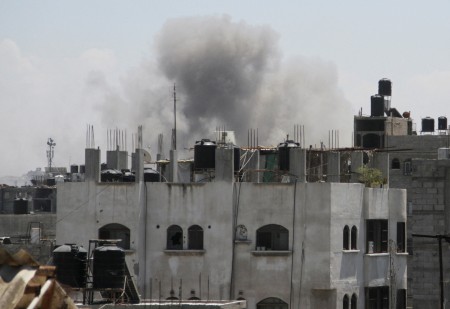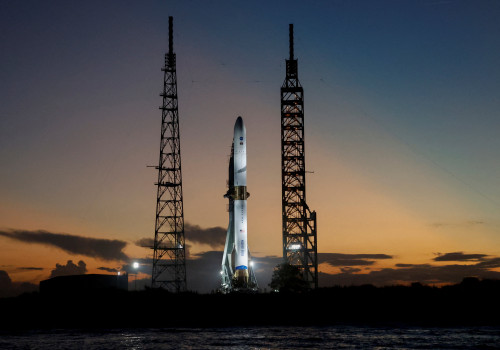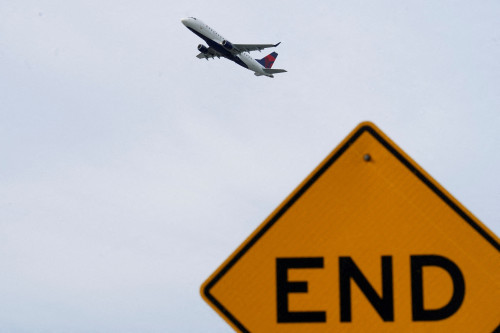By Nidal al-Mughrabi
CAIRO (Reuters) -Israeli forces pushed deep into the ruins of Gaza’s northern edge on Monday to recapture an area from Hamas fighters, while in the south tanks and troops pushed across a highway into Rafah, leaving Palestinian civilians scrambling to find safety.
Some of the most intense fighting for weeks is raging in both the north and south. Israeli operations in Rafah, which borders Egypt, have closed a main crossing point for aid, which humanitarian groups say is worsening an already dire situation.
Hundreds of thousands of people are being forced to flee again after around half of Gaza’s population took sanctuary there after being pushed south by fighting elsewhere.
Gaza’s health authority appealed for international pressure to reopen access via the southern border to allow in aid, medical supplies and fuel to power generators and ambulances.
“The wounded and sick suffer a slow death because there is no treatment and supplies and they cannot travel,” it said.
A foreign U.N. staff member was killed on Monday when a vehicle travelling to a hospital in Rafah was struck – the first international U.N. casualty in the Gaza war, a U.N. spokesperson said.
In northern Gaza’s Jabalia, a sprawling refugee camp built for displaced Palestinians 75 years ago, Israeli forces pushed into an area where they claimed to have dismantled Hamas months ago.
Residents fled along rubble-strewn streets carrying bags of belongings. Tank shells landed in the centre of the camp and health officials said they had recovered 20 bodies from overnight airstrikes.
“We don’t know where to go. We have been displaced from one place to the next… We are running in the streets. I saw it with my own eyes. I saw the tank and the bulldozer. It is on that street,” said one woman, who did not give her name.
The Palestinian death toll in the war has now surpassed 35,000, with 57 killed in the past 24 hours, according to Gaza health officials, whose figures do not differentiate between civilians and fighters.
Israeli troops are seeking to wipe out Hamas, which has said it is committed to Israel’s destruction. The militant group burst into Israel on Oct. 7, killing 1,200 and taking more than 250 hostages, by Israeli tallies.
Hamas’ armed wing said because of Israeli bombardments it had lost contact with militants guarding four Israeli hostages, including U.S.-Israeli citizen Hersh Goldberg-Polin, who appeared in a video released by Hamas in late April.
Attending a Memorial Day ceremony to mark Israel’s fallen soldiers in Jerusalem on Monday, Prime Minister Benjamin Netanyahu said the war against Hamas was a struggle to secure Israel’s “existence, liberty, security and prosperity”.
“Our war of independence is not over yet,” he said.
In Rafah, Israel stepped up aerial and ground bombardments on the eastern areas of the city, killing people in an airstrike on a house in the Brazil neighbourhood.
Residents said Israeli air and ground bombardments were intensifying and tanks had cut off the main north-south Salahuddin road dividing east of the city from the central area.
“The tanks cut the Salahuddin road east of the city, the forces are now in the southeast side, building up near the built-up area. The situation is dreadful and the sounds of explosions never stopped,” said Bassam, 57, from the Shaboura neighbourhood in Rafah.
“People continue to leave Rafah … no place looks safe now and people do not want to escape at the last minute,” he told Reuters via a chat app.
BLINKEN BRIEFED
UNRWA, the main U.N. aid agency in Gaza, estimated that about 360,000 people had fled the southern city since the Israeli military gave its first evacuation order a week ago.
They are moving to empty tracts of land, including Al-Mawasi, a small strip of land along the coast, designated as an expanded humanitarian area by Israel.
But Shaina Low of the Norwegian Refugee Council aid agency said it was not set up to receive uprooted families.
“(There’s) no space to install latrines or water points. There are huge piles of solid waste. My colleague spoke about seeing donkey carcasses on top of trash, so there are all sorts of health concerns,” Low said.
The assault on Rafah has caused one of the biggest splits in decades between Israel and its main ally the United States, which paused some deliveries of weapons for the first time since the war began. Washington says Israel must not assault Rafah without a plan to protect civilians, which it has yet to see.
Israeli Defence Minister Yoav Gallant’s office said on Monday he had briefed U.S. Secretary of State Antony Blinken on the “precise operation” in the Rafah area.
Hamas’ armed wing said its fighters were engaged in gun battles with Israeli forces in one of the streets east of Rafah, and in the east of Jabalia.
In Israel, the military sounded sirens several times in areas near Gaza, warning of potential Palestinian cross-border rocket and or mortar launches.
Israeli protesters blocked aid trucks headed for Gaza, strewing food packages on the road at Tarqumiya checkpoint, west of Hebron in the Israeli occupied West Bank.
Hamas and the armed wing of Islamic Jihad said in a joint statement that they fired mortar bombs against Israeli forces massing inside the Rafah crossing, which Israel captured last week.
(Reporting by Nidal al-Mughrabi in Cairo; Additional reporting by Dan Williams, Tala Ramadan, Emily Rose and Ali Sawafta; Emma Farge in Geneva; Writing by Sharon Singleton and Ros Russell; Editing by Peter Graff and Alison Williams)











